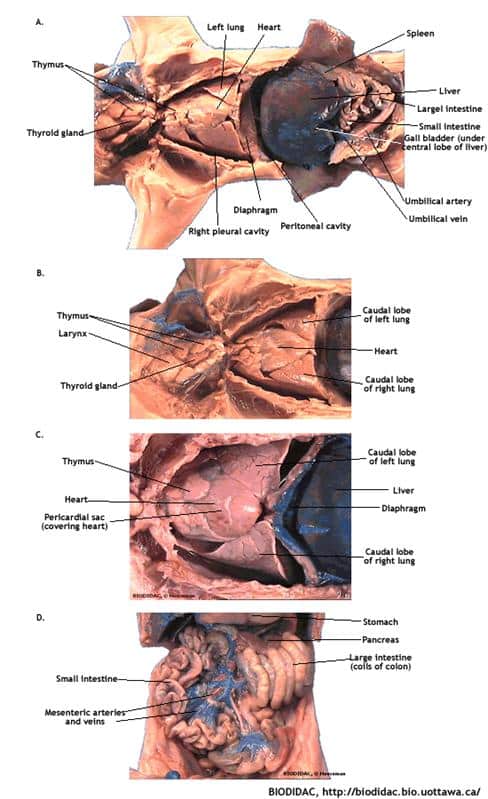Procedure
Part 1 – External Anatomy
- Identify and record the 4 main body segments
- Examine the head of your pig
- Note the eyes. Each eye is protected by three eyelids! The third eyelid is the nictitating membrane – a small mass of tissue in the corner of each eye.
Part 2 – Internal Anatomy
- Be careful when dissecting your fetal pig.
- Only remove organs that you are asked to remove. Make superficial incisions before cutting deeper.
Dissection set up
- Using a piece of string, tie one of the pigs ankles.
- Place the pig ventral side up on the dissection tray.
- Bring the string under the dissection tray and tie the opposite wrist.
- Repeat for the other wrist and ankle to expose the ventral surface.
Incisions
- Using either a scalpel or dissection scissors, make incision
- Be careful. Do not cut very deep. It is better to begin with shallow incisions.
- Cut from the umbilical chord to the head
- Using your scalpel, make incisions
- Begin at the umbilical chord and cut toward the posterior end of the fetal pig on either side of the chord.
- Using dissection scissors, make incision across the collar of the pig.
- Find where incision ends along the posterior end of your pig. Using a scalpel, make incision down each hind leg.
- Locate the rib cage of your pig. The final incision will go directly below the ribs. Use dissection scissors to cut along the ribcage.
- Be very careful so you do not damage any of the internal organs.
Exposing the Internal Organs
- Begin folding back the flaps of skin at incision
- Pin down the flaps to expose the internal organs.
- Note the layer of connective tissue holding the abdominal organs in place.
- This tissue is called peritoneum.
- Carefully remove the peritoneum to expose the internal organs.
- Fold back the posterior flap made by incisions. Pin it down.
Organ Identification for the Abdominal Cavity
- The liver will be brown or dull red
- It will be found at the anterior end of the abdominal cavity, right below the ribs.
- Look for the gall bladder, it will be right below the liver.
- Find the duct connecting the gall bladder and the gall bladder.
- Identify the portion of the Small Intestines that the duct connects to.
- Next, identify the stomach. The stomach will be partially covered by the liver.
- Locate where the stomach connects to the esophagus.
- Using dissection scissors, cut the esophagus just above the stomach.
- Repeat this for where the stomach joins the duodenum.
- Now, use your dissection scissors to open the stomach.
- Record what you see inside the stomach.
- Our next organ of interest is the pancreas. The pancreas will be found below the stomach.
- It will be resting against the back wall of the abdominal cavity.
- The spleen will be found near the pancreas, along the left abdominal wall.
- Lastly, identify the small and large intestines. Take hold of the duodenum.
- Slowly pull the duodenum. The small intestines are lined in a membrane called the mesentery.
- Continue to pull out the Small Intestine until it is fully unraveled.
- Measure the length of the Small Intestine.
Organ Identification for the Thoracic Cavity
- If you have not already pinned back the thoracic cavity flaps, do so now.
- You may need to use the surgical scissors to cut through the sternum
- Locate the heart. The heart is found just left of the center of the thoracic cavity.
- Use the forceps to remove the pericardium membrane from the heart.
- You will now begin removing the heart
- Use your blunt probe to locate the right atrium.
- Using your scissors, separate the atrium from the superior and inferior vena cavae
- Next, locate the left atrium with your blunt probe.
- Again, use your scissors to separate the heart from any connecting vessels.
- Separate the aorta from the left ventricle.
- Separate the pulmonary trunk from the right ventricle.
- Carefully remove the heart from the thoracic cavity.
Dissection of the Heart
- Make a small incision separating the left and right sides of the heart.
- Make a cut through the wall of one of the ventricles.
The Lungs
- Locate the lungs within the thoracic cavity.
- Run you finger over the trachea and the lungs.


Thanks! This helped a lot!!!
I had to do this last week. YUM!
this is helpful but weird